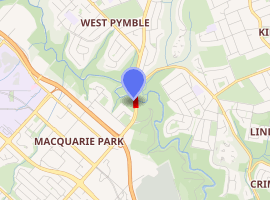De Burghs Bridge
The De Burghs Bridge is a road bridge that carries the Lane Cove Road, part of the A3, across the Lane Cove River in Macquarie Park, Sydney, New South Wales, Australia. The bridge stretches from Macquarie Park in the south to West Pymble in the north.
De Burghs Bridge | |
|---|---|
| Coordinates | 33°46′32″S 151°08′07″E |
| Carries |
|
| Crosses | Lane Cove River |
| Locale | Macquarie Park, Sydney, New South Wales, Australia |
| Named for | Ernest de Burgh |
| Followed by | Fullers Bridge |
| Characteristics | |
| Material | Concrete |
| No. of lanes | 3 (north); 3 (south) |
| History | |
| Opened | December 1967 |
| Replaces | De Burghs Bridge (first bridge) |

| |
History
The current De Burghs Bridge is the second bridge with this name to cross the Lane Cove River in this area.
First bridge
Old De Burghs Bridge | |
|---|---|
 Opening of old De Burghs Bridge in 1901 | |
| Coordinates | 33°46′33″S 151°08′10″E |
| Carries | Lane Cover Road |
| Crosses | Lane Cover River |
| Other name(s) | Lane Cove Bridge |
| Named for | Ernest de Burgh |
| Followed by | Fullers Bridge |
| Characteristics | |
| Design | Truss bridge |
| Material | Timber |
| Total length | 91 metres (300 ft) |
| Longest span | 50 metres (165 ft) |
| Clearance below | 30 metres (100 ft) |
| History | |
| Designer | Ernest de Burgh |
| Opened | 22 December 1900 |
| Inaugurated | 23 February 1901 |
| Collapsed | 1994 (bushfire) |
| Closed | 1967 |
| Replaces | Older east/west bridge |
| Replaced by | 2nd De Burghs Bridge |

| |
| References | |
| [1][lower-alpha 1] | |
The first bridge with this name was designed in 1899 by Ernest de Burgh, after whom the bridge is named, and was opened on 23 February 1901. It was situated downstream from the current bridge, within metres at the southern end, and about 20 metres (66 ft) away from the current bridge at the northern end. The single De Burgh timber truss bridge was 91 metres (300 ft) in length, the largest truss was 50 metres (165 ft), the longest timber truss span ever built in Australia.[2][3]
The old bridge was destroyed by bushfire in January 1994. The northern abutment on the ground is still visible, as are parts of the supporting piers. The new bridge offers a vantage point to view the remnants of the original structure.
Second bridge
The bridge was replaced by two large high-level multi-lane separate concrete bridges, built alongside each other, and it opened in December 1967.[4] The current bridge is a six-lane bridge that, unlike the original timber truss, is perpendicular to the river. This demonstrates how far road and bridge building had progressed by the 1960s, as previously it was dictated by the form of the land. One can see how the newer road and bridge is built right over any land formations, in contrast to the winding old road.
De Burghs Bridge is similar in form and function to Roseville Bridge, being a high-level multi-lane bridge replacing a low level, narrow bridge as well as windy approach roads.
De Burghs Bridge is an important part of a significant north–south artery which is the next road between the northern suburbs and the lower northern suburbs after Pennant Hills Road. The bridge carries three lanes of traffic each way and a pedestrian walkway on either side of the bridge. A plaque placed on the bridge pays tribute to the old bridge. It was placed there in 1988 before the destruction of the old bridge.[5]
Notes
- Map shows Pittwater Road continuing past the cemetery and turning west across a bridge over the Lane Cove River.
References
- Old parish map (Map). 1907.
- "MINISTERIAL VISIT TO RYDE". The Sydney Morning Herald. New South Wales, Australia. 25 February 1901. p. 3 – via National Library of Australia.
- "THE LANE COVE BRIDGE AND THE FIELD OF MARS TRAM". Australian Town and Country Journal. LXII (1621). New South Wales. 2 March 1901. p. 23. Retrieved 20 November 2016 – via National Library of Australia.
- "Mona Vale Road, Ryde Road, Lane Cove Road, Homebush Bay Drive, Centenary Drive, Roberts Road & King Georges Road (A3)". Road photos & information: New South Wales. Paul Rands. 2 January 2019. Retrieved 28 March 2020.
- De Burghs Bridge. Bicentennial Plaque affixed to bridge. De Burghs Bridge. 1988.
External links
- "de Burgh, Ernest Macartney (1863–1929)". Australian Dictionary of Biography. Melbourne University Press. ISSN 1833-7538 – via National Centre of Biography, Australian National University.
- "At De Burgh's bridge". The Cumberland Argus and Fruitgrowers Advocate. Parramatta, New South Wales. 17 February 1923. p. 8 – via Trove, National Library of Australia.
- "Flashback - 75 years ago: FIRST DE BURGHS BRIDGE OPENED" (PDF). Main Roads. New South Wales: Commissionerfor Main Roads. 41: 125–127. June 1976.